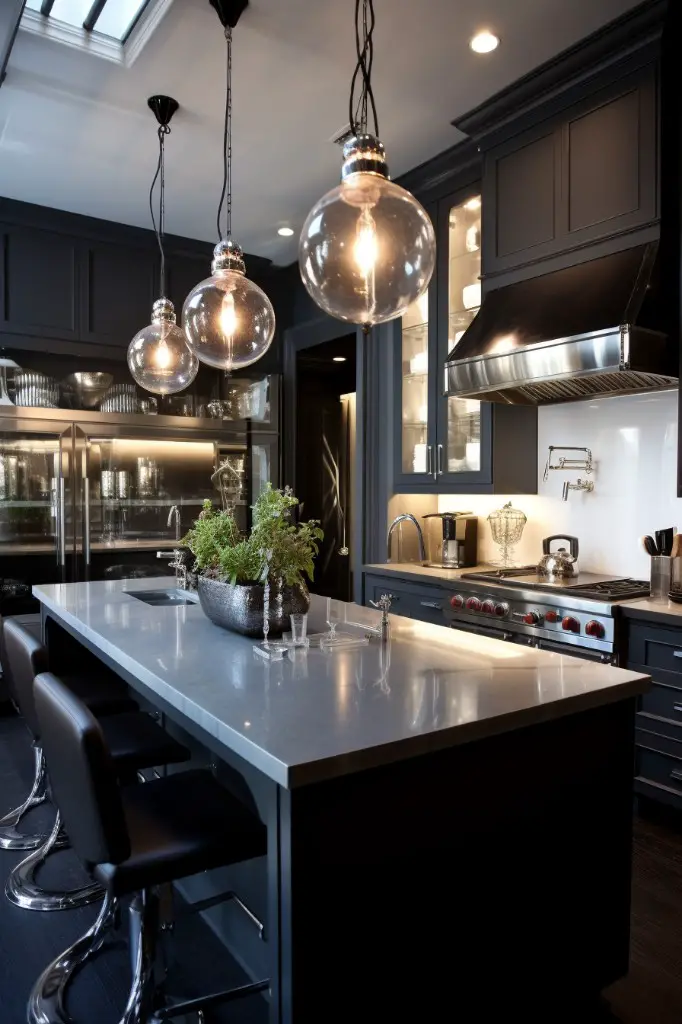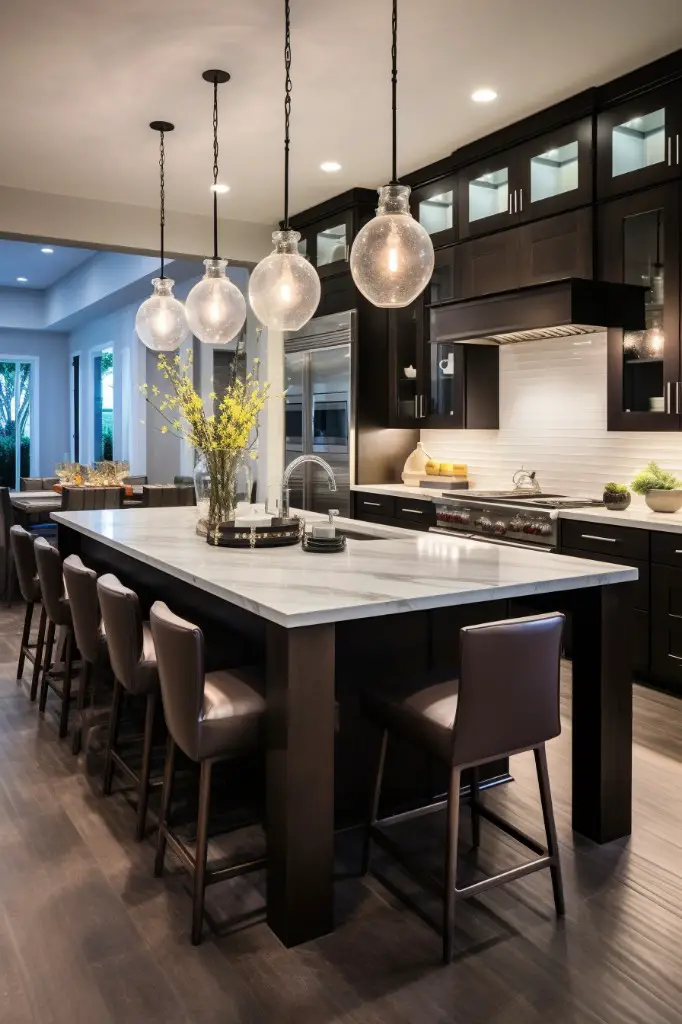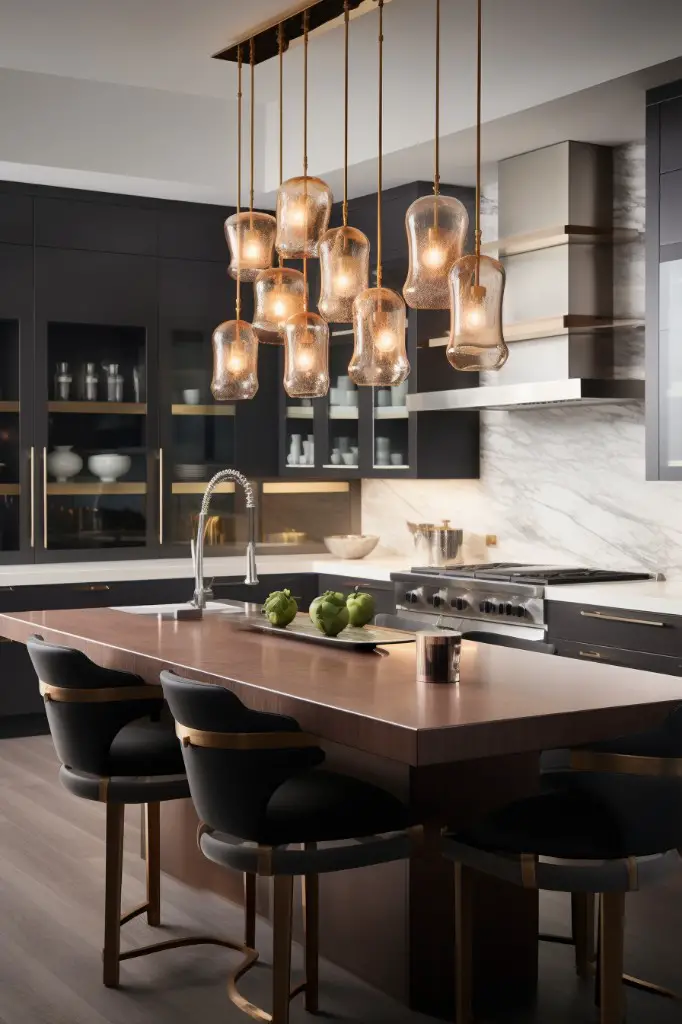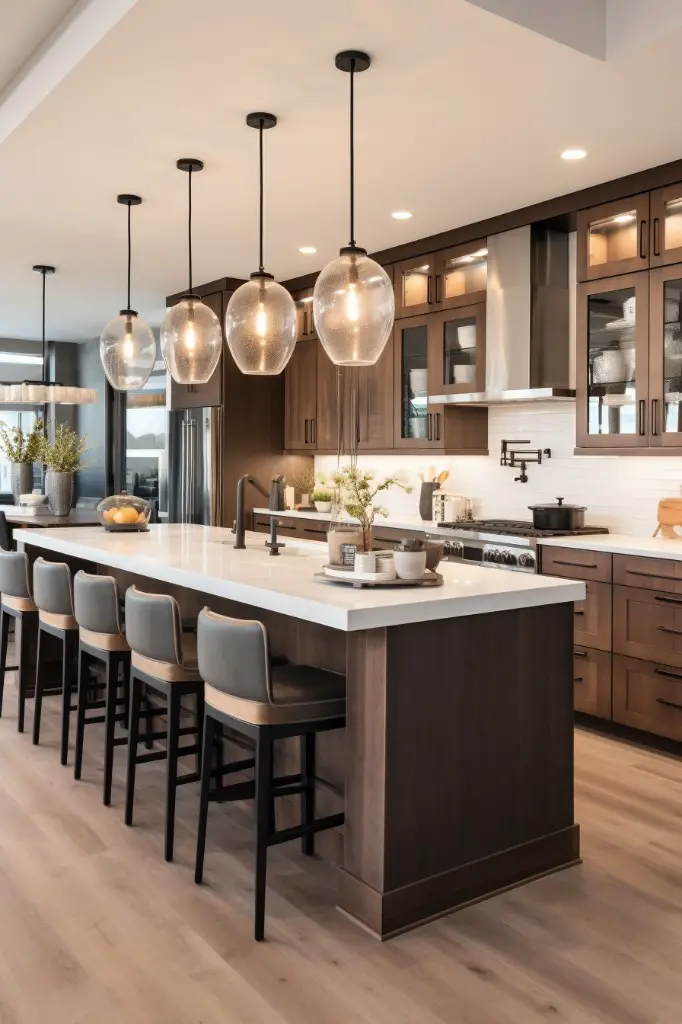Last updated on
Discover the impact of coordinating light fixtures with kitchen hardware to create visual harmony and elevate your home’s aesthetic appeal.
When it comes to home decor, the little details can make a big difference. One question that often arises in kitchen design is whether or not light fixtures should match the hardware on cabinets and drawers.
It may seem like a minor consideration, but choosing the right lighting and hardware can have a significant impact on the overall look and feel of your kitchen. In this article, we’ll explore this topic in depth and help you decide whether or not matching your light fixtures to your kitchen hardware is the right choice for you.
So let’s dive in!
What's Inside
Importance of Kitchen Hardware

Kitchen hardware is an essential element of any kitchen design. It includes cabinet handles, drawer pulls, knobs, and hinges that are used to open and close cabinets and drawers.
While these may seem like small details in the grand scheme of things, they can have a significant impact on the overall look and feel of your kitchen.
Hardware not only serves a functional purpose but also adds visual interest to your space. The right hardware can complement other elements in your kitchen such as countertops or backsplashes while also providing contrast where needed.
When choosing hardware for your kitchen cabinets or drawers, consider factors such as style preference (modern vs traditional), material (metal vs wood), finish (matte vs glossy) among others. These choices will help you create a cohesive look throughout the entire room.
Light Fixtures and Kitchen Design

They not only provide necessary illumination for cooking and food preparation, but they also contribute to the overall ambiance of the space. The right lighting can make your kitchen feel warm and inviting or bright and energizing, depending on your preferences.
When it comes to choosing light fixtures for your kitchen, there are several factors to consider. First and foremost is functionality – you want lights that will adequately illuminate all areas of the room where you’ll be working most frequently.
But beyond that, you’ll also need to think about style. Do you prefer modern or traditional designs? Are there specific finishes or materials that appeal to you? And perhaps most importantly for this article’s topic: should those light fixtures match with other elements in your kitchen?
Matching light fixtures with hardware is one way homeowners can create visual harmony within their kitchens while elevating its aesthetic appeal at once.
Matching Vs. Contrasting Styles

Matching styles involve coordinating the finishes and colors of your light fixtures with the hardware on cabinets and drawers. This creates a cohesive look that ties everything together in a harmonious way.
On the other hand, contrasting styles can add visual interest to your kitchen by introducing different textures, materials, and finishes. For example, if you have sleek stainless steel appliances and hardware in your kitchen but want to add some warmth to space, consider adding brass or copper light fixtures for an eye-catching contrast.
Ultimately whether you choose matching or contrasting style depends on personal preference as well as practical considerations such as budget constraints.
Pros and Cons of Matching Light Fixtures and Hardware

It’s important to consider both the pros and cons before making a decision.
Pros:
- Visual harmony: Matching light fixtures with hardware creates visual consistency in your kitchen design.
- Easier decision-making: Choosing matching pieces eliminates the need to spend time searching for complementary options.
- Classic appeal: A coordinated look is timeless and can add value to your home.
Cons:
- Limited options: Limiting yourself to only matching pieces may restrict creativity or limit available choices.
- Monotonous appearance: Too much coordination can make a space feel boring or one-dimensional.
- Ultimately, whether you choose to match your light fixtures with your kitchen hardware depends on personal preference. If you prefer simplicity and classic style, then coordinating these elements might be right for you. On the other hand, if you enjoy mixing styles or want more variety in design choices, then contrasting styles could be an option worth exploring.
Types of Light Fixtures
Pendant lights, chandeliers, track lighting and recessed lighting are just a few of the most popular types of light fixtures that can be used in kitchens. Each type has its own unique style and function.
Pendant lights are a great option for adding visual interest to your kitchen while providing task lighting over an island or dining table. Chandeliers add elegance and sophistication to any space but may not be practical in smaller kitchens due to their size.
Track lighting is versatile as it allows you to direct the light where you need it most while also serving as an accent piece on its own. Recessed lighting provides ambient illumination throughout the entire room without taking up valuable ceiling space.
Different Styles of Kitchen Hardware
From sleek and modern to rustic and traditional, the style you select can have a significant impact on the overall look of your kitchen. Some popular options include brushed nickel or chrome for a contemporary feel, brass or bronze for an antique touch, and black matte finishes for an industrial vibe.
It’s important to consider not only the style but also the functionality when selecting hardware. For example, if you have young children in your home who may struggle with opening cabinets with knobs that require twisting motion; then choosing handles instead could be more practical.
Ultimately it’s about finding what works best for your personal taste as well as how functional they will be in everyday use. Matching light fixtures with these different styles is possible but requires careful consideration of color coordination tips such as balancing textures and finishes in order not create visual chaos within space.
Material Considerations
The materials you choose can have a significant impact on the overall look and feel of your kitchen. For example, if you have stainless steel appliances in your kitchen, then matching them with brushed nickel or chrome light fixtures can create a cohesive look.
On the other hand, contrasting materials such as brass or copper hardware paired with matte black lighting fixtures can add an interesting visual element to your space. It’s important to consider not only how these elements will look together but also how they will function in terms of durability and maintenance.
Some popular options for light fixture materials include glass, metal (such as brass or bronze), wood (for rustic styles), and even fabric shades for softer lighting effects. When it comes to hardware choices there is no shortage of options either – from classic knobs made out of ceramic or crystal glass that evoke vintage charm; sleek modern pulls crafted from polished chrome; all the way up through more exotic finishes like leather-wrapped handles!
Color Coordination Tips
The right combination of colors can create a cohesive and visually appealing look in your kitchen. One way to achieve this is by selecting light fixtures that complement the color of your hardware.
For example, if you have brass or gold-toned cabinet handles and drawer pulls, consider choosing warm-colored lighting such as amber or soft white bulbs for your overhead fixtures. On the other hand, if you have silver-toned hardware like stainless steel knobs and pulls on cabinets and drawers, cooler tones like blue-white lights may be more suitable.
Another approach is to use contrasting colors for an eye-catching effect. For instance, black matte finishes on pendant lights can provide an elegant contrast against shiny chrome-finished cabinet handles.
Balancing Textures and Finishes in the Kitchen
The right combination of materials can create visual interest and depth in the space. However, too many contrasting elements can make the room feel cluttered or overwhelming.
To achieve balance in your kitchen design, consider using complementary textures and finishes that work well together. For example, pairing matte black hardware with brushed stainless steel light fixtures creates a cohesive look without being too matchy-matchy.
Another way to balance textures is by incorporating natural materials like wood or stone into your design scheme. These organic elements add warmth and texture while creating contrast against sleeker surfaces like metal or glass.
Ultimately, finding the right balance between different textures and finishes requires careful consideration of each element’s role in the overall design scheme.
Mixing Metals: A Modern Approach to Kitchen Design
While matching light fixtures with hardware can create a cohesive look, mixing metals allows you to play with contrasting textures and finishes for an eye-catching effect. For example, pairing brushed nickel hardware with brass light fixtures creates an elegant yet contemporary vibe.
When it comes to mixing metals in the kitchen, there are a few things you should keep in mind. First, choose one dominant metal finish as your anchor point – this will help guide your other choices and prevent the overall look from becoming too chaotic or overwhelming.
Next, consider balancing warm tones (such as gold or copper) with cooler ones (like silver or chrome) for visual contrast. You may also want to experiment by incorporating different textures into the mix – think matte black pendant lights paired with shiny stainless steel appliances.
Ultimately, mixing metals is all about finding balance between complementary elements while still making bold design choices that reflect your personal style preferences.
Achieving Balance in Design
This means creating a space that feels cohesive and harmonious, with all elements working together seamlessly. One way to achieve this balance is by coordinating your light fixtures with your kitchen hardware.
Matching light fixtures and hardware can create a sense of unity in the space, tying everything together visually. However, it’s important not to go overboard – too much matching can make the room feel sterile or boring.
To strike the right balance between coordination and contrast, consider mixing metals or materials for an eclectic look that still feels intentional. For example, you might pair brass cabinet handles with matte black pendant lights for an unexpected yet stylish combination.
Ultimately, achieving design harmony requires careful consideration of each element in the room – from lighting and hardware to cabinetry and countertops – as well as how they work together as a whole.
Tips for Creating a Harmonious Kitchen Space
When it comes to matching light fixtures with hardware, there are several tips you can follow to ensure that your kitchen looks cohesive and visually appealing.
Firstly, consider the overall style of your kitchen. If you have a modern or minimalist aesthetic, then sleek and simple light fixtures will complement this look well.
On the other hand, if your kitchen has more traditional or rustic features, then ornate lighting may be more appropriate.
Secondly, think about color coordination. Matching metals like stainless steel or brushed nickel can create a polished look while contrasting finishes like black matte hardware with brass lighting can add visual interest.
Thirdly don’t forget texture! Mixing textures such as wood grain cabinets paired with glass pendant lights creates depth in design without being too overwhelming on the eyes.
Popular Design Trends
In recent years, there has been a shift towards more modern and minimalist styles in kitchen design. This means that many homeowners are opting for sleek, simple hardware and light fixtures that complement their clean-lined cabinetry.
Another popular trend is mixing metals to create an eclectic look in the kitchen. For example, you might choose brass cabinet handles and pair them with copper pendant lights for a unique yet cohesive aesthetic.
If you’re looking to add some personality to your kitchen while still maintaining a modern feel, consider incorporating bold pops of color into your lighting or hardware choices. Brightly colored knobs or statement pendant lights can be just what’s needed to bring life into an otherwise neutral space.
DIY Customisation Ideas
There are plenty of ways to create unique light fixtures and hardware that match your style and preferences. For example, you can paint or spray-paint existing fixtures in a color that complements the hardware finish.
Alternatively, consider replacing standard knobs with vintage or handmade ones for added character.
Another idea is creating pendant lights using mason jars or repurposed items like colanders or baskets. These DIY projects not only save money but also allow homeowners to express their creativity while adding value and personality into their homes.
However, it’s important not to go overboard with customization as it may clash with other design elements in the kitchen if done excessively. It’s best practice always keeping balance in mind when making any changes within the space.
Case Studies On Successful Kitchen Makeovers
In one case study, a homeowner opted for brushed nickel cabinet pulls and knobs to match their stainless steel appliances. They also chose pendant lights with similar finishes to create visual harmony in the space.
In another example, a homeowner went for contrasting styles by pairing black matte hardware with brass light fixtures. The result was an eye-catching design that added depth and character to their modern farmhouse-style kitchen.
These examples demonstrate how coordinating or contrasting lighting fixtures with your cabinet hardware can transform your space into something truly special. Whether you prefer traditional or contemporary designs, there are endless possibilities when it comes to creating a cohesive look in your home.
Consulting Interior Designers
These professionals have the expertise and experience to help you make informed decisions about all aspects of home design, including lighting and hardware choices. They can provide valuable insights into current trends, color coordination tips, material considerations and more.
An interior designer can also help ensure that your kitchen’s overall aesthetic is cohesive by balancing textures and finishes throughout the space. They may suggest mixing metals for a modern look or incorporating eco-friendly light fixtures for a sustainable touch.
Working with an interior designer doesn’t have to break the bank either – many offer affordable consultation services that allow homeowners to get expert advice without committing to a full-scale redesign project.
Ultimately, whether or not you choose to match your light fixtures with your kitchen hardware is up to personal preference.
Eco-friendly Light Fixtures
Not only do they help reduce energy consumption and lower your electricity bill, but they also have a positive impact on the environment. LED lights, for example, use up to 80% less energy than traditional incandescent bulbs and last much longer too.
When choosing eco-friendly light fixtures for your kitchen, consider options such as pendant lights made from recycled materials or those that incorporate natural elements like bamboo or wood. You can also opt for smart lighting systems that allow you to control the brightness of your lights with ease.
By incorporating eco-friendly light fixtures into your kitchen design plan, you not only create an environmentally conscious space but also add a touch of sophistication and elegance to it.
Smart Lighting Integration
With the rise of smart homes and Internet of Things (IoT) devices, integrating your light fixtures with other smart appliances can make your life easier and more convenient.
Imagine being able to control the brightness and color temperature of your kitchen lights with just a voice command or tap on your smartphone. Smart lighting systems like Philips Hue or LIFX allow you to do just that.
You can also set schedules for when certain lights turn on or off, create custom scenes for different moods, and even sync up with music or movies.
When it comes to matching light fixtures with kitchen hardware in a smart home setup, there are endless possibilities. For example, you could program all the lights above cabinets to turn blue when someone enters the room at night – creating an ambient glow that won’t disturb anyone sleeping nearby.
Maintaining Consistency in Open-Concept Layouts
They offer a spacious feel and allow for seamless transitions between different areas of the home. However, with this type of layout comes the challenge of maintaining consistency throughout the space.
When it comes to matching light fixtures with kitchen hardware in an open-concept layout, it’s important to consider how each area flows into one another. You want your lighting and hardware choices to complement each other without being too matchy-matchy or overwhelming.
One way to achieve consistency is by choosing similar finishes or materials that tie everything together while still allowing for some variation in style. For example, if you have brushed nickel cabinet handles in your kitchen area, you could choose pendant lights with brushed nickel accents over your dining table.
Another approach is using lighting as a unifying element throughout the space by selecting fixtures that share similar shapes or design elements but vary slightly depending on their location within the room.
How Lighting Affects the Overall Kitchen Ambiance
The right lighting can create an inviting atmosphere that makes your kitchen feel warm and welcoming. On the other hand, poor lighting can make even the most beautiful space feel dull and uninviting.
When it comes to designing your kitchen’s lighting scheme, there are several factors to consider. First of all, you need to think about how much natural light enters your space throughout the day.
If you have large windows or skylights that let in plenty of sunlight during daylight hours, you may not need as many artificial lights.
However, if your kitchen doesn’t get much natural light or if it’s located on a lower level with limited access to sunlight altogether – then artificial lights become more important for creating ambiance.
Another factor worth considering when choosing light fixtures for kitchens is their placement within the room itself: overhead fixtures like chandeliers or pendant lamps provide general illumination while under-cabinet task lights help illuminate specific areas such as countertops where food preparation takes place.
Lighting plays an essential role in setting up a comfortable environment inside our homes; therefore we must pay attention when selecting them according to our needs and preferences so they match well with other elements present inside our living spaces such as hardware finishes etcetera!
FAQ
Does kitchen hardware need to match light fixtures?
Kitchen hardware does not need to match light fixtures, but they should complement each other and blend with the rest of the house.
Should cabinet hardware match faucet or light fixture?
Yes, generally, your kitchen faucet should match your cabinet hardware to create a cohesive look suitable for all kitchen styles.
Should light fixtures match door handles?
Light fixtures should complement door handles but not match exactly, as too much of one metal can create a flat, static look.
What should kitchen cabinet hardware match?
Kitchen cabinet hardware should match the cabinet color, considering light and dark-colored cabinets to be paired with hardware finishes that make the pulls and hinges stand out.
How important is consistency in the overall design of kitchen fixtures and hardware?
Consistency in the overall design of kitchen fixtures and hardware is highly important for maintaining aesthetic harmony and functionality.
Can mixing different metals in light fixtures and hardware create a cohesive aesthetic?
Yes, mixing different metals in light fixtures and hardware can create a cohesive aesthetic.
Are there specific design styles that require matching light fixtures and kitchen hardware?
Yes, specific design styles such as traditional, modern, and farmhouse often require matching light fixtures and kitchen hardware for a cohesive look.





